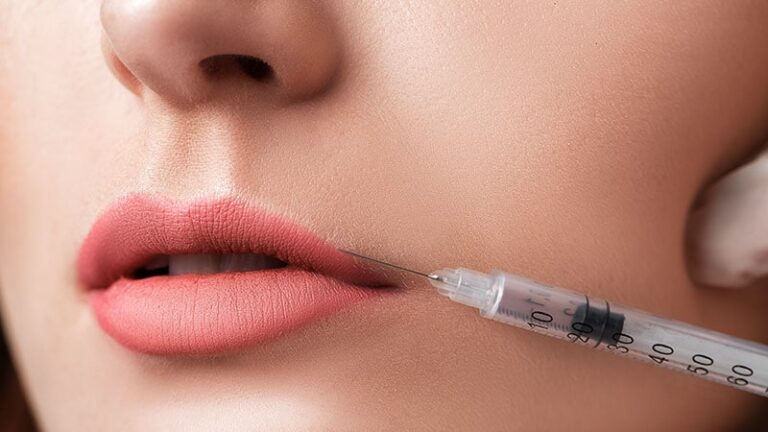In recent years, the field of aesthetic medicine has seen a rapid increase in the use of intradermal injections of hyaluronic acid and botulinum toxin. Unfortunately, this boom has been accompanied by an increase in side effects, especially since these injections are not always given by people trained and accredited in the practice. Martine Baspeyras, MD, dermatologist in Bordeaux specializing in aesthetic dermatology and cosmetology, and president Vigilance Esthetique, The French society for the regulation of cosmetic dermatology procedures addressed the situation at a press conference held before Journées Dermatologiques de Paris dermatology conference.
Hyaluronic Acid Injections
Aesthetic medicine has seen a meteoric rise in recent years in Western countries, with a growing market in botulinum toxin and hyaluronic acid injections for wrinkle filling and facial volume loss. Hyaluronic acid acts differently, depending on its concentration and cross-linking. Its massive action reshapes the face and reduces wrinkles. Stimulates fibroblasts, collagen production and elastic fibers: Stimulates tissue regeneration. It also has a long-lasting moisturizing effect. These are temporary benefits that require frequent injections to maintain the aesthetic effect achieved. “Injections are minimally invasive medical procedures that should only be administered in a medical setting that complies with good practice,” said Baspeyras.
Dealing with Complications
The most common and less serious side effects of cosmetic injections are hematoma, or redness, associated with the fact that a needle has pierced a small blood vessel that has consequently bled. These side effects are temporary and will disappear in about 10 days or so. “They are less common than they were 10 years ago, thanks to the use of new methods to give these injections, such as through cannulas,” Baspeyras said.
Sometimes, cosmetic procedures go wrong, leading to asymmetry and excessive swelling. Another non-serious risk is that correction attempts may fail, resulting in an unpleasant result (the opposite of what was intended) because the hyaluronic acid was not injected in the right place or has migrated. “Medications can be given to correct injection errors,” Baspeyras said.
Other complications, such as when the product is injected into a small artery, are fortunately very rare — only one case has been reported in France. This complication can cause a hyaluronic acid embolism that affects blood circulation in an area of the face, causing tissue necrosis. The doctor will then institute a treatment protocol that includes an enzyme to break down hyaluronic acid, combined with a blood thinner.
Similarly, swelling or nodules may occur after the injection. If they persist, the doctor may take a sample for histology to determine the cause. When bacteria are found, following poor unsanitary conditions, antibiotic treatment should be prescribed.
Administration of injections
Patients should be informed before having a cosmetic injection. This disclosure is intended to prevent common and rare risks. “But one of the major challenges in the field of cosmetic dermatology is the misuse of these injections by non-physicians, such as beauty therapists, hairdressers and manicurists, who believe they are qualified to administer hyaluronic acid or Botox injections after watching a webinar that shows them how to do it,” Baspeyras said. Patients who visit dermatologists to correct complications from beauty injections say, “The woman who does my nails said, I’ve learned how to give injections and I can give them to you!’ “Injecting in a salon, outside of a medical environment is wrong, not to mention illegal! You may pay a little less than you would with a doctor, but the risk of complications is much higher,” warned Baspeyras, who is also a legal expert.
Before giving an injection, make sure that certain rules are followed. The person doing the injection must be a physician, knowledgeable about hygiene practices, and thoroughly studied and trained in facial anatomy. “But a side effect can be due to the product itself, the person who injected it, or even the patient,” Baspeyras said. This is why practitioners of these cosmetic injections must take a complete history of the patient before the procedure to ensure that the patient is not experiencing a herpes outbreak, psoriasisor eczema, and that it does not have chronic inflammation.
Injections should not be given to patients experiencing an autoimmune flare and in any case, injections should only be given to people whose health status is stable and whose medication history is known.
Doctors should also ask about any dental problems their patients may have before giving the injection. Examining the teeth and gums allows the practitioner to check for abscesses that could promote infection after the injection. “A doctor will rarely do more than three syringes per session to let the hyaluronic acid sit in place, for good absorption and to ensure that both sides of the face are symmetrical,” said Baspeyras, who also advises patients “to learn to say no, giving reasons why an injection should not be given” when the conditions required for cosmetic surgery are not met, from the doctor’s point of view. He issued another warning: Don’t inject someone the same day they come to see you. Wait a second. “Beauty procedures are never urgent,” said Baspeyras.
Rescue experts
Faced with an injection-related complication, a group of French experts in Cosmetology (Vigipil/Vigidec) has been established at the French Society of Dermatology. “Any physician who presents with a patient suffering from an injection-related complication can contact the team and they will determine the course of action to take, Baspeyras explained. We offer virtual treatment advice once the contacting physician has completed the complication reporting form.” The creation of this group is even more important because legally, this is what affects the patient who is responsible if there are any subsequent consequences. The expert group also encourages the reporting of all side effects.
This article was translated by Medscape French edition.


